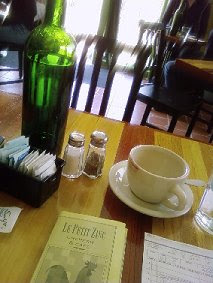
I am writing about balsamic vinegar today because it would be a shame for anyone to think that the extent of balsamic vinegar ends with $4 brown acid-water on the grocery store shelf. If it did, the term "Vinegar Tasting" surely would not exist. But as it is, perfectly reasonable people are known to taste, and enjoy, balsamic vinegar straight from a spoon or even a small glass. Why? Because true balsamic vinegar is a magically sweet, tart, and complex condiment made with very specific ingredients, in a very specific place, and according to a very particular centuries-old process.
True balsamic vinegar is strictly controlled by Italian law and can only come from one of two Italian cities, Modena or Reggio Emilia. Known as
Aceto Balsamico Tradizionale di Modena (or
di Reggio Emilia), this vinegar is made from the juice (or
must) of the white Trebbiano grape, which has been boiled down and aged in various wooden barrels for a minimum of twelve years, then has been approved by master tasters. The process produces a condiment as thick as syrup and amazingly complex - not only sweet and sour, but also containing flavors often ascribed to wine - stewed fruit, musk, and tobacco, for example. That said, there is a 'catch'. As you might guess, something requiring such an artisan (and lengthy - balsamic vinegars can be aged for 50 years or more) process isn't always easy to come by. And if you do, it's not exactly cheap.
Fortunately, something between the
tradizionale and the aforementioned brown acid-water does exist. That "something", or rather
somethings, are in the form of
Aceto Balsamico Condimento or even
Aceto Balsamico di Modena ("Industriale" Balsamic). Condimento has been made according to the traditional process, but for the exception of one variable. Thus, it does not qualify for consortium approval, perhaps because it has not been aged for twelve years, or because it has not been aged in the proper types of wood, or even just because it was made outside the boundaries of Modena and Reggio Emilia.
Condimento can still be pricey, but is considered to offer a good value because it is made in a style similar to the
tradizionale, but can be obtained at perhaps half the cost.
Possessing a bit of a tricky name,
Aceto Balsamico di Modena is really "cheater" balsamic, made using grape must, but possibly also red wine vinegar, sugar or a quick caramelization process, and/or wood chips. To be called balsamic at all, these need to be aged at least three years. While there is no guarantee that an
Industriale will be good, many are, and it is worth one's while to seek out a decent bottle, which will be in roughly the $10 to $20 price range. Buy it, and it will become a kitchen staple, but will still last a long time.
And the $4 brown acid-water? That's imitation balsamic, most likely cider vinegar with some caramel coloring added. At that price point, it can't possible be balsamic!
 We moved to Chicago in October and have been busy getting to know our new city and enjoying our new CSA winter share (finally!). But now it's time to get back to business...
We moved to Chicago in October and have been busy getting to know our new city and enjoying our new CSA winter share (finally!). But now it's time to get back to business...































 Originally, I didn't make this salad for garlic.pepper.parsley, but because I was hungry! It was so pretty when it was done, though, that I couldn't help but take a picture. Then, while looking at the picture, it came to me that maybe this little quick-meal trick of mine might be useful to others, so I decided to post it.
Originally, I didn't make this salad for garlic.pepper.parsley, but because I was hungry! It was so pretty when it was done, though, that I couldn't help but take a picture. Then, while looking at the picture, it came to me that maybe this little quick-meal trick of mine might be useful to others, so I decided to post it.







